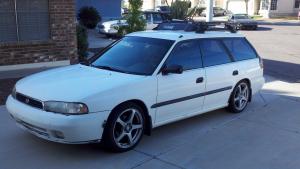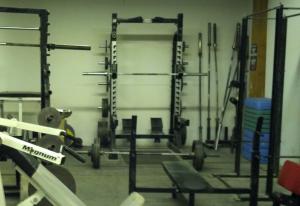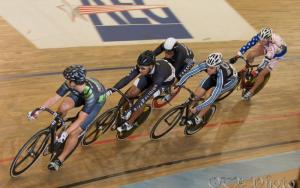Even without advertising that I used to be an almost competitive sprinter based in a state with no track and the closest one was over 5 hours away, it seems that I end up answering this question at least a few times a year. This time I’m answering it to the world both out of laziness to avoid future typing and if we’re lucky to help inspire a potential sprinter or two with no track and no one to ask. Most of this isn't hard to figure out and much is very similar to what you could do if you did live near a track, but trying to figure it all out at once seems to be just enough to make it seem harder then it is and to discourage some.
 First of all, becoming a good track sprinter with no track can’t be done. You absolutely need some quality time on the track to really learn tactics, proper passes, picking fast lines and just generally getting comfortable and confident on the banking. You will need to travel, unless you’ve already been doing this for decades, and if so you're probably not reading this for informational purposes anyway. One weekend every month or two would be the bare bones minimum that I'd recommend. I also highly recommend having a larger block of time within a couple months of your target event. Spend a week or two at a track, ideally one similar to the one your target event will be held at and get as much track and racing time as possible without burning yourself out. I often opted for one close to family so that I could use my travel time more effectively; luckily it also happened to be a track with a very friendly (but aggressive) sprint culture (Alpenrose Velodrome).
First of all, becoming a good track sprinter with no track can’t be done. You absolutely need some quality time on the track to really learn tactics, proper passes, picking fast lines and just generally getting comfortable and confident on the banking. You will need to travel, unless you’ve already been doing this for decades, and if so you're probably not reading this for informational purposes anyway. One weekend every month or two would be the bare bones minimum that I'd recommend. I also highly recommend having a larger block of time within a couple months of your target event. Spend a week or two at a track, ideally one similar to the one your target event will be held at and get as much track and racing time as possible without burning yourself out. I often opted for one close to family so that I could use my travel time more effectively; luckily it also happened to be a track with a very friendly (but aggressive) sprint culture (Alpenrose Velodrome).Wait, wait, wait, back up, you said "almost competitive". Why in the world would I want to listen to you? Don't, if don't think it can be done you could just quit now and take up competitive hopscotch or something. My main shortcomings as a sprinter with no track were not directly from not having a track; they were from not quite knowing how to properly train as a sprinter. I came up under a very good endurance coach with some track experience who had me on a program that would have been great for a points racer with a couple chunks of old school track sprint training mixed in. And in general the general trend back then was higher volume sprint training. Turns out that I, like many sprinters in various sports, do better with much higher intensity and lower volume. If I knew then what I know now, I would have been trouble. Hell, give me a few more years and if age and work don't slow me down any more then they have been, I'll still be trouble. Being closer to a track my odds of realizing this sooner probably would have been much better, but you kids these days have loads of great sprint training hints on the internet and also thanks to the internet it's easier to find a good coach to work with remotely then ever before, so that shouldn't be your limiting factor. If nothing else, go read fixed gear fever.
Training
Much of training will be very similar. There will always be conflicting opinions as to what the best training program consists of and I'll be avoiding most of that in this post. But it's of primary importance no matter where you are to make or get a training program that you believe in and follow it. If you're just starting out and have the funds I recommend hiring a quality coach with established results. Currently in the US there is no shortage of good sprint coaches, but don't expect them to be cheap and many will (or at least should) want to work with you in person from time to time, which probably means even more travel. All that aside and no matter which style of sprint training you end up heading toward, as a sprinter you are going to need more strength and speed work then any other flavor of bike racer.
Strength
 The gym is the gym, you should be in it and should enjoy it. Some sprinters do well with getting all of their strength on the bike, but you don't live near enough to a track and likely aren't working with one of the very few coaches that do that well, so spend your brain power figuring out some other part of your training program or planning travel to tracks and lift heavy weights for your main strength work. Hit the classic lifts with proper squats and dead lifts as the core of your lifting, you can get fancy and do all kinds of other stuff, but it's yet more to think about and possibly get wrong and arguably won't work as well anyway.
The gym is the gym, you should be in it and should enjoy it. Some sprinters do well with getting all of their strength on the bike, but you don't live near enough to a track and likely aren't working with one of the very few coaches that do that well, so spend your brain power figuring out some other part of your training program or planning travel to tracks and lift heavy weights for your main strength work. Hit the classic lifts with proper squats and dead lifts as the core of your lifting, you can get fancy and do all kinds of other stuff, but it's yet more to think about and possibly get wrong and arguably won't work as well anyway. In addition to the gym, for on the bike strength, I highly recommend standing and seated starts/accelerations in progressively larger gears. Treat them just like lifting weights with super high intensity in every effort, low reps and adequate rest between efforts. You definitely do not need a track for this work. In fact out of connivence even living in Chicago where we have two tracks (Northbrook and CVC) and several more a short drive away (Kenosha, Major Taylor), I do all of these on my track bike out on a reasonably filthy street near my house. You just need to find a flat stretch of road with no intersections or driveways to one side that is roughly 200 meters long or longer. Ideally it will have at least a slight uphill near the end or a consistent head wind to help you slow down after your efforts. Most of my efforts are roughly 80 meters long and the rest of the distance is used to safely slow down.
In addition to the gym, for on the bike strength, I highly recommend standing and seated starts/accelerations in progressively larger gears. Treat them just like lifting weights with super high intensity in every effort, low reps and adequate rest between efforts. You definitely do not need a track for this work. In fact out of connivence even living in Chicago where we have two tracks (Northbrook and CVC) and several more a short drive away (Kenosha, Major Taylor), I do all of these on my track bike out on a reasonably filthy street near my house. You just need to find a flat stretch of road with no intersections or driveways to one side that is roughly 200 meters long or longer. Ideally it will have at least a slight uphill near the end or a consistent head wind to help you slow down after your efforts. Most of my efforts are roughly 80 meters long and the rest of the distance is used to safely slow down.Speed work
Fake track work: Unless you live somewhere with no hills (or even over passes), you can do almost anything that you would do on a track on a local road, you just need to be a bit more creative. Such as, find a small hill that dumps out onto a long straight stretch of road with no intersections or driveways and treat it like dropping down the banking to the sprint lane for your flying 50m, 100m, 150m, 200m, 500m, 1000m and whatever else efforts.
Small fixed gears: I used to spend a decent amount of time in very small gears on fixed gear group rides and it resulted in the best leg speed that I've ever had. Down hill city sign style sprints in really small gears can really kick up the leg speed, they really force you to pedal smoother at high cadences (or you'll destroy your junk) and they're fun. If you easily kill your competition, get a smaller gear and/or slower wheels for the next time. Just don't stop pedaling and please put at least one break on. In my travels I've found that many areas of the country have groups of mostly road riders that do fixed gear road rides for part of the year, look and ask around or start your own or even just take your fixed gear on a group ride with geared bikes.
Motor pace: Find and bribe a friend with a motor cycle to take you out motor pacing on your favorite stretch of straight flat road and do normal motor paced workouts. Another option, which is less safe, but easily one of my all time favorites are delivery truck sprints! Find a flat stretch of road with a 35-45mph speed limit where delivery trucks (or some other large vehicle) travel at roughly 40mph on a regular basis and practice taking a run at them. Ideally it would be a stretch with a small downhill at the beginning to help get you up to speed before the actual effort. While going high 20s to low 30s, let the truck pass you, accelerate hard, come up in the trucks draft, swerve out (to which ever side is safer) right before you'd hit the bumper and try to make the pass. Just like passing on the track, you want the majority of your acceleration to happen while still in the draft so that you hit a higher top speed and make the pass faster thus increasing your odds of a successful pass. The main points of caution are being ready to swerve early if the truck hits the breaks and giving space to the side as you pass the truck as some drivers will be startled when you come around and may swerve a little.
Tactics
Even with frequent traveling you are going to be at a tactical disadvantage to people who get to practice and race on the track all the time. One way to minimize this (that I really wish were as easy as it is now back when I was doing this) is to make watching race footage part of your weekly training. Once a week spend some time on youtube watching footage of the current and past greats. Watch their technique and tactics as closely as possible. Note how tactics have changed as the average gear sized used increased over time.
Bumping
 These days the official sprint rules on the track don't allow too much bumping, but any self respecting sprinter needs to know how to handle his/her self when it happens anyway (and it will). Find a way to practice this periodically throughout the year. For initial work, I'm a big fan of either lining up a pair or rollers and positioning you and a buddy in various configurations or rolling slowly on grass. As a minimum, get used to elbow to elbow, shoulder to shoulder and elbow to hip contact. Bonus rounds include head to hip / ribs / shoulder, letting hands hit when you don't have your elbows out, knee to handle bar and any thing else you can think up. The worst one I've ever had in real life was foot to foot still not sure how that one happened, but it hurt like hell and was pretty hard to keep the bike upright from. The key for any contact is to stay cool and keep your weight mostly over your own damn bike. Once you're comfortable, you can lean into your opponent all you want, but once you lean onto your opponent you're putting a lot of faith in his/her ability to handle things, which for the most part just isn't wise. Always be prepared for the other rider to crash or abruptly swerve away. Once you're comfortable with all of that, I'm a big fan of taking a friend or two on easy or endurance rides and just screwing with each other for the entire ride, but in a semi safe way of course. In college my two roommates (Adam and Justin) and I would go out and see how close we could come to pushing each other into things (garbage cans, curbs, parked cars, trees), but without actually ever hurting each other. Arguably one of the most fun things I've ever done on a bike.
These days the official sprint rules on the track don't allow too much bumping, but any self respecting sprinter needs to know how to handle his/her self when it happens anyway (and it will). Find a way to practice this periodically throughout the year. For initial work, I'm a big fan of either lining up a pair or rollers and positioning you and a buddy in various configurations or rolling slowly on grass. As a minimum, get used to elbow to elbow, shoulder to shoulder and elbow to hip contact. Bonus rounds include head to hip / ribs / shoulder, letting hands hit when you don't have your elbows out, knee to handle bar and any thing else you can think up. The worst one I've ever had in real life was foot to foot still not sure how that one happened, but it hurt like hell and was pretty hard to keep the bike upright from. The key for any contact is to stay cool and keep your weight mostly over your own damn bike. Once you're comfortable, you can lean into your opponent all you want, but once you lean onto your opponent you're putting a lot of faith in his/her ability to handle things, which for the most part just isn't wise. Always be prepared for the other rider to crash or abruptly swerve away. Once you're comfortable with all of that, I'm a big fan of taking a friend or two on easy or endurance rides and just screwing with each other for the entire ride, but in a semi safe way of course. In college my two roommates (Adam and Justin) and I would go out and see how close we could come to pushing each other into things (garbage cans, curbs, parked cars, trees), but without actually ever hurting each other. Arguably one of the most fun things I've ever done on a bike.Motivation
One of the main things that you will likely be missing out on that you would have at a track is having competitors (friends and/or foes) that are of similar ability to drive and motivate you. Find what motivates you and capitalize on it. Many need a nemesis. Thinking of how your nemesis wouldn't quit can be very helpful during hard efforts. Visualizing blowing past them out of turn four can be very helpful when doing a sprint on the road. Finding a proper power lifting style gym (few to no mirrors, chalk, several squat racks, loads of weight, no pretty boys trying to pick up chicks and more chalk) where the odds of you being the strongest person in the gym are 0 can be great for adjusting your view of what is possible and often times if you're not a jerk you'll build some friendships with other lifters who will help motivate, advise and push you through your gym sessions.
Stay Clean
Last by certainly not least; don't buy into the hype that all good sprinters are juiced up. At least while coming up in AZ many years ago I found that the majority of people in the area that paid any attention to track sprinting thought that most good track sprinters were juiced up. I have no doubt that some cheat, but know that many don't and that is most certainly not necessary. In fact, especially when you're no where near your genetic limitations, I would strongly argue that an intelligent training program, good motivation and patience can help you more then cheating would and it wouldn't actually be you accomplishing anything anyway if you cheated, it would be the drugs. Being at a track frequently racing and training with people, you would eventually get a good feeling for who is clean and who is not and see that they're not necessarily faster. Being off at a distance you miss out on that.